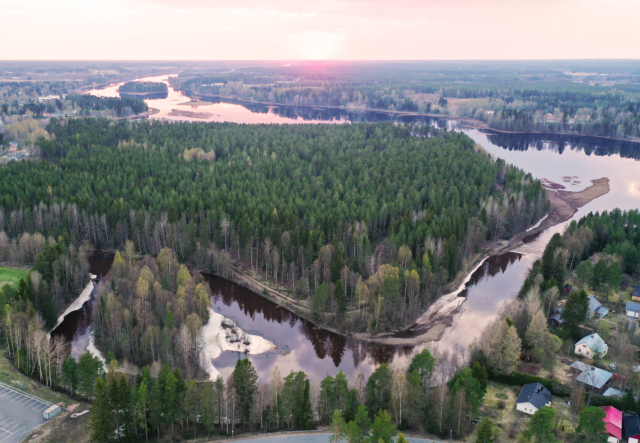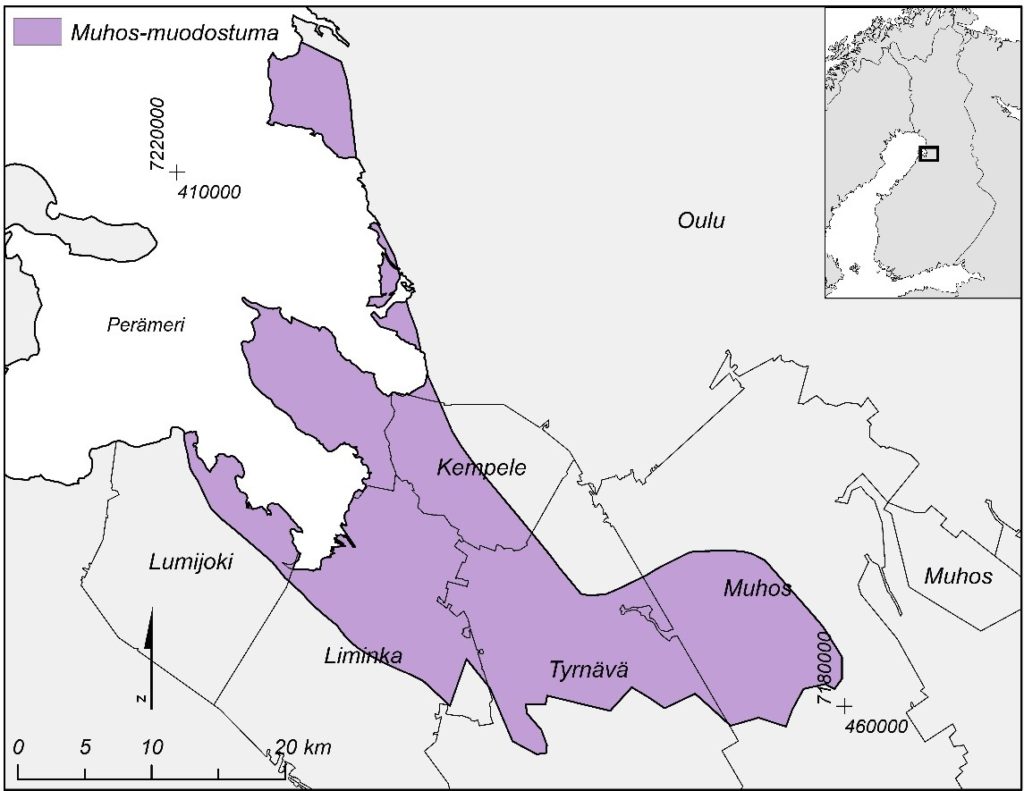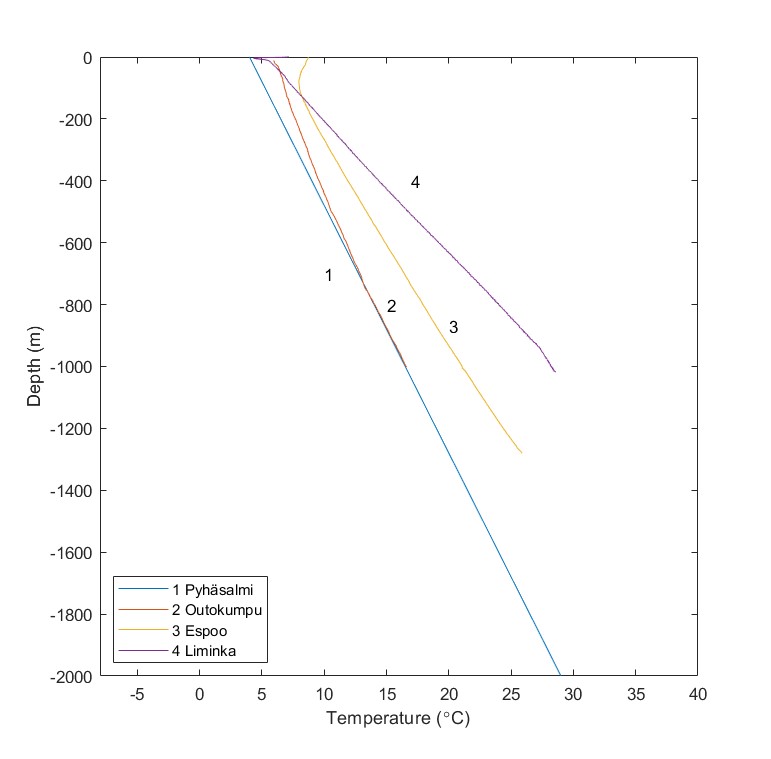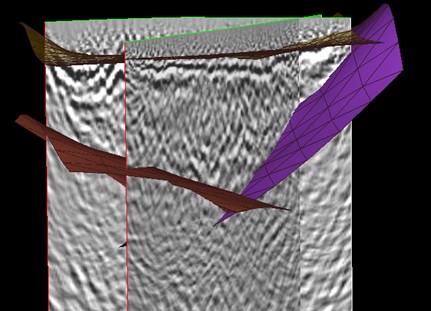Carbon Neutral Geothermal Energy from the Muhos Formation
The Muhos formation has a significant, as-yet unutilised, potential of medium-deep geothermal energy. The Geological Survey of Finland (GTK) evaluated the geothermal energy potential of the Muhos formation and, in more detail, of the islet of Kirkkosaari in Muhos, where a new residential area is planned. Modern modelling methods with geophysical research can successfully demonstrate the potential of the formation as a source of environmentally friendly energy and guide the placement of geothermal wells of different lengths in optimal locations.

The Muhos Formation Offers Attractive Conditions for Medium-deep Geothermal Energy
The Muhos formation, a geologically interesting and large sedimentary rock formation, being up to one kilometre in thickness, offers attractive conditions for using medium-deep (approx. 1–3 km) geothermal energy in the Oulu region. According to the survey conducted by GTK’s geoenergy group, the thermal output of a single two-kilometre-deep geothermal well is as promising as for the same borehole length in the most productive rapakivi granite area in southern Finland, where bedrock conditions, the geothermal heat flow, and the thermal conductivity are otherwise more favourable.
In the Muhos formation area, the continuous 24/7 thermal power of a medium-deep (2 km) geothermal well drilled in an optimal location is roughly 120 kW, which is equivalent to an annual energy yield of one gigawatt-hour. By comparison, the continuous thermal power of a one-kilometre-deep geothermal well is 37 kW at best, which is equivalent to an annual energy yield of 324 megawatt-hours. However, the thermal output of a shallow (300 m) geothermal well, is mainly lower in the Muhos formation area than in the rest of Finland. The annual energy yield of one 300-metre-long well in different parts of the Muhos formation varies between 12.8 and 31.8 megawatt-hours.

Mainly consisting of claystone, the Muhos formation differs from its surrounding geology based on its physical properties. In general, sedimentary rocks in the formation have a lower thermal conductivity than that of rocks in crystalline bedrock which, together with a thick soil cover, act as an insulating layer for heat flow upwards. In the Muhos formation, the subsurface temperature rises steeply as the depth increases, with the temperature at the bottom of the formation being higher than at similar depths in other parts of Finland. The high subsurface temperature makes the Muhos formation an attractive location for medium-deep geothermal wells, in particular.

GTK Identified the Potential of Geothermal Energy by Studying Geological Scenarios
GTK’s research report ′Geotermisen energian hyödyntämismahdollisuuksien arviointi Muhos-muodostuman ja Muhoksen Kirkkosaaren alueilla′ (Evaluation of the geothermal energy potential in the areas of the Muhos formation and Kirkkosaari in Muhos) was prepared based on the survey assigned by the municipality of Muhos. The thermal output of shallow (300 m) and medium-deep (1 km and 2 km) geothermal wells was modelled numerically in different geological scenarios considering the thickness and quality of the soil cover and the impact of the claystone thickness, in addition to the fluid volumetric flow rate and heat outtake. The scenarios were studied in the Muhos formation and more specifically, in the islet of Kirkkosaari in Muhos, where a new residential area is planned.
The scenario studies demonstrated that, the output of a geothermal well depends on the physical properties of subsurface and their heterogeneity over the borehole length. Regardless of the length of a geothermal well when drilled solely in a claystone formation, the output is poorer due to the lower thermal conductivity. In addition, the thick soil cover significantly reduces the output of shallow geothermal wells. Thus, special attention should be paid to the location selected for each well, especially the shallow ones. To utilize the geothermal heat beneath the Muhos formation, a medium-deep geothermal well needs to be drilled through the claystone formation, deep enough to properly access the crystalline bedrock. For a two-kilometre-deep geothermal well, one potential location occurs in Tupos in the municipality of Liminka, where the claystone formation extends to the depth of 977 metres.
Deep Geophysical Methods Helping to Identify the Subsurface Structure
Geophysicists and fieldworkers conducted audio-magnetotelluric (AMT) soundings and reflection seismology in Kirkkosaari to identify the subsurface structure. In the seismic reflection surveys, new wireless SmartSolo geophones were used as receivers. The surveys conducted in Kirkkosaari marked the first research project implemented using SmartSolo equipment, and the wireless receivers proved to be easy to use in fieldwork conditions.
Significant variations in the thickness of the soil cover and claystone formation were discovered in different parts of Kirkkosaari. The claystone formation revealed to be shaped like a wedge, extending to the depth of nearly half a kilometre at deepest, in the central part of the islet. In addition, the claystone may be weathered on its surface and there is a possible fracture in the northern part of Kirkkosaari. These factors can affect drilling, increase the need for borehole casing, flushing and reinforcement, and thus increase drilling costs. The data obtained from geophysical measurements were used in the more detailed heat transfer modelling to reliably estimate the geothermal energy yield in the geological conditions of Kirkkosaari. It was also important to identify where geothermal wells of different lengths should be located in the Kirkkosaari area.

Towards Climate-friendly Energy Production Using Geological Information and Modelling
Understanding geology, combined with deep geophysical methods, and simulating the geothermal energy output based on it provide solutions towards low carbon energy production. These lay a firm foundation for the use of geothermal energy. We have strong expertise and effective tools for promoting the potential and technologies of geothermal energy, also in northern Finland.
Text
Annu Martinkauppi, Energy and Construction Solutions, Geological Survey of Finland, annu.martinkauppi@gtk.fi
Source
Martinkauppi, A., Piipponen, K., Huusko, A., Heinonen, S. & Lahti, I. 2021. Geotermisen energian hyödyntämismahdollisuuksien arviointi Muhos-muodostuman ja Muhoksen Kirkkosaaren alueilla. Summary: Evaluation of the geothermal energy potential in the areas of the Muhos formation and Kirkkosaari in Muhos. Geological Survey of Finland, Open File Research Report 46/2021. 47 p.
